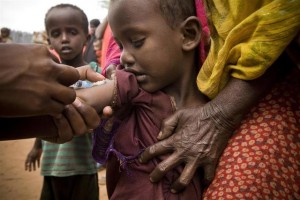「非洲之角」開展疫苗接種行動 保護營養不良兒童免患病死亡的生死綫
2011-07-26
奈洛比/香港,2011年7月26日——聯合國兒童基金會(UNICEF)、肯尼亞衞生部及世界衞生組織本星期正式在北肯尼亞開展防疫注射行動,為達達阿比難民營周邊社區的兒童接種疫苗。是次行動是預防災區大規模爆發致命疾病重要的一步,預料可為202,665名5歲以下兒童,接種麻疹及小兒麻痺症疫苗,並為他們提供維他命A及驅蟲藥片,有效預防受災兒童染上小兒麻痺症,及防止患有營養不良的兒童因感染麻疹而致命。

| 南索馬里的防疫注射覆蓋率只有26%,是全球比率最低的國家之一。UNICEF的救援隊伍,上周四已在索馬里首都摩加迪休開展有關行動,為當地8個地區及區內難民營的婦女及兒童進行疫苗接種,至今已接種疫苗的5歲以下兒童及婦女分別有有40,000名及46,000名。而在蓋多,救援隊伍亦正為當地6個地區預備麻疹疫苗、破傷風類毒素疫苗、維他命A及驅蟲藥片,預計將有55,000名5歲以下兒童及72,580名育齡婦女受惠。只要交通能夠確保暢順,UNICEF將與世界衞生組織合作,進一步將行動迅速擴展至加勒加度、大貝納迪爾、拜洲、巴科勒、希蘭、下謝貝利及朱巴,為各區合共250萬名15歲以下受災兒童全面接種麻疹疫苗。 |
「這是一次關乎兒童生死存亡的嚴重危機。」聯合國兒童基金會東南非地區主任Elhadj As Sy先生指出:「很多時,兒童死亡並不只是因為饑餓,營養不良導致他們罹患各種疾病反而是最大的原因。因此,如果災區的營養不良率再不下降的話,兒童的性命就岌岌可危了。」
據此,各組織將進一步擴大北肯尼亞的防疫注射行動,預計至本周五(7月29日)行動將可擴展至加里薩、Fafi、Lagdera及南瓦吉爾,並於8月為達達阿比難民營提供服務。UNICEF已準備好足夠的麻疹與小兒麻痺症疫苗、維他命以及驅蟲藥片應付需求,並會支援社區的宣傳及教育工作,幫助當地居民認識防疫注射的重要性。

麻疹是一種高傳染性的疾病,在過於擁擠和衞生情況惡劣的環境下,極易迅速擴散,威脅營養不良兒童的生命。麻疹大大降低兒童的抵抗力,令他們很容易在營養不良或患上其他疾病的情況下,因感染致命疾病而死亡。尤其在災難中,不少兒童會都會患上維他命A缺乏症,相比正常人,他們患上麻疹、瘧疾或腹瀉的機會率足高出25%。因此,給受災兒童服用維他命A,能有效提高他們在惡劣環境下生存的機會。
UNICEF預計未來半年所需的救援資金,將達到港幣23.4億元(3億美元),以為整個索馬里南部災區的兒童提供緊急救援及採取預防措施。我們將重點進行預防工作,為兒童提供醫療以及疫苗接種服務,以確保他們的生存與發展。









